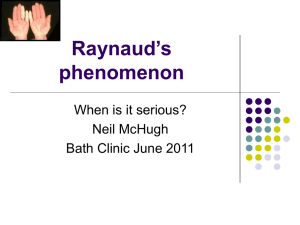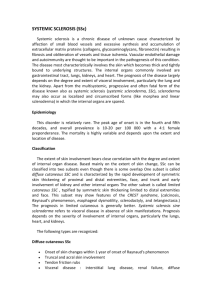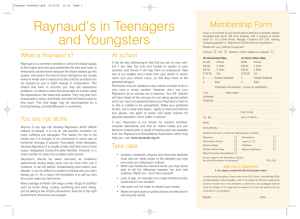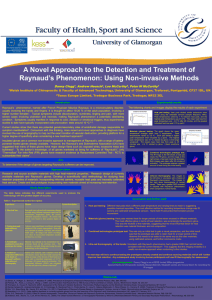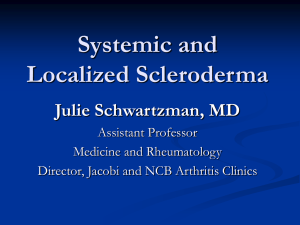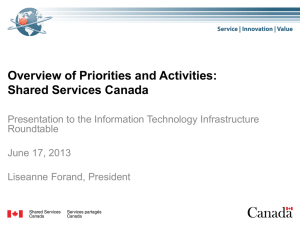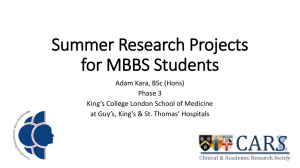Scleroderma Dermatomyositis
advertisement
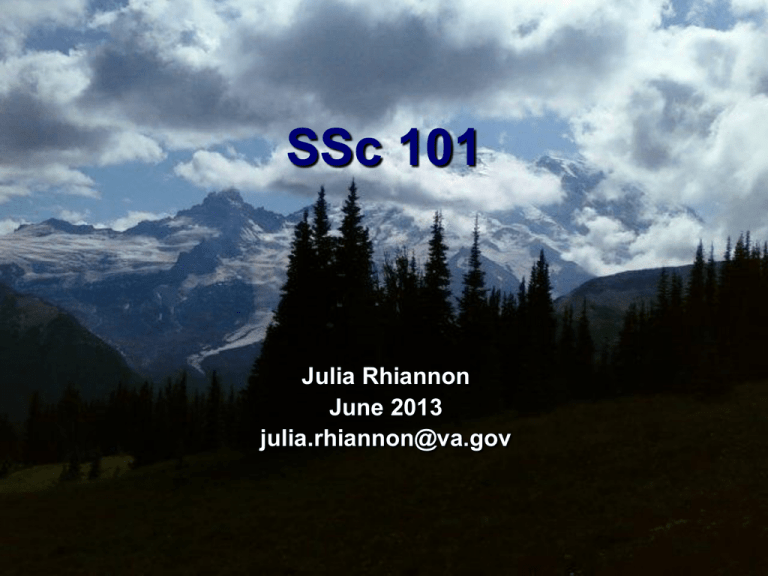
SSc 101 Julia Rhiannon June 2013 julia.rhiannon@va.gov outline • Intro and pathogenesis • Classification • dcSSc ~ diffuse cutaneous systemic sclerosis – organ involvement with 2 cases – Rodnan skin scoring • lcSSc ~ limited cutaneous systemic sclerosis & case • Antibodies as clues to phenotype • Environmental/genetic contribution and epi • Therapy SSc clinical manifestations result from... • Autoimmunity • Small vessel obliterative vasculopathy – Raynaud’s, renal crisis, PAH • Pathological accumulation of collagen in skin and other organs – Sceroderma, lung parenchymal dz, GI dysmotility Chicken vs Egg – Pathogenesis and autoantibodies Gu, S., et.al., Seminars in Arthritis, 2008 Localized Scleroderma Morphea Linear Scleroderma Coup de Sabre Case 1: Puffy Hands • HPI - 45 y/o woman with 5 wks of puffy hands – recently finger turns white while grocery shopping or reaching into refrigerator. Hands feel itchy. • Exam - Diffusely swollen hands and wrists. Several fingers cyanotic. Pulses intact. Case: Puffy Hands The next step would be: 1. Check for nailfold changes 2. Doppler study 3. Order ANA panel 4. Order ANCA 5. Skin biopsy 6. Pred 60mg IM x1 7. Tell her to take her husband’s viagra Skin: Raynaud’s • Classic three color change: -pallor (vasoconstriction) -cyanosis -rubor (least frequent) • Triggered by cold and emotion Raynaud’s • Raynaud’s affects 3-5% of general population – Most are primary, usually with onset in 20s-30s • Raynaud’s assoc with SSc will likely have : – Increased severity in freq/duration/morbidity – Nailfold cap abn (47% PPV) – Positive serologies (ANA 30%PPV) – With stiffness and/or pitting +/- ulcers – Age >35 Nailfold Capillaroscopy Normal Dilatation Dropout Dilatation Bizarre Loops Images in Raynaud’s Cyanosis Digital pitting Treatment of Raynaud’s • Central warmth, good gloves, avoid cold exposure, handwarmers • Stress reduction • Dihydropyridine calcium channel blockers – nifedipine 30mg ER titrate up as tolerated • Phosphodiesterase 5 inhibition (sildenafil/revatio/viagra) • Topical nitroglycerin for 20 minutes (or more) tid proximal to affected digit • Po and IV prostanoids (alprostadil) • Endothelin receptor antagonist (Bosentan) • Statins • Antiplatelet (ASA) and antioxidant (NAC) Severe Digital Ischemia • Treatment of impending digital gangrene requires hospitalization • Warm room, pain meds, anxiolytics, high dose Ca channel blockers or trial of IV alprostadil (5 nanograms/kg/min for 6 hours followed by 10 nanograms/kg/min for 66 hours via PICC line), • Antibiotics if infection present • May try sympathetic block at the wrist; consider digital sympathectomy if successful • Initially skin may be edematous • Hands only early • May have CTS • Edema resolves; skin then indurated • Extremities, face, trunk may be involved • Advancing skin involvement often pruritic Early Skin Changes in Diffuse SSc Late Skin Changes • • • • As disease progresses, skin becomes atrophic Ulcers may develop at pressure points or with trauma Disappearance of finger tips due to resorption or gangrene Secondary joint contractures Other skin changes • Other – Thickened and tethered – Telangiectasia – Calcinosis – Narrowed oral aperture Case 2 • 44 y/o male with known Next step is to give: dcSSc admitted to 1. plasma exchange MICU for – BP 210/150 – creatinine 1.5 mg/dl. 2. IV Solu-Medrol & Cytoxan – UA with +2 protein 3. IV nitroprusside – Smear with schistocytes 4. ACEi (enalaprilat or po enalapril) 5. Renal bx STAT Scleroderma Renal Crisis • Defined as accelerated arterial hypertension and/or rapidly progressive oliguric renal failure. • Occurs in 10% of patients with scleroderma • Occurs in 20-25% of pts with the RNA Pol III Ab • Etiology - mimics malignant htn, 2/2 microvasc dz, vasospasm, and tissue ischemia… with elevated renin, and arteriolar fibrotic change • Knowledge from clinical studies: – Must keep exquisite control of BP – When in renal crisis use ACEs before ARBs or any other – Corticosteroids thought to predispose patients to renal crisis Renal Involvement in diffuse scleroderma • Renal Crisis – rapidly progressive azotemia – malignant hypertension – microangiopathic hemolytic anemia – thrombocytopenia – proteinuria, hematuria Scleroderma renal crisis/malignant Htn arteriolar fibrinoid necrosis Syndromes in Systemic Sclerosis • Vascular – Raynaud’s Phenomenon – Renal Crisis – Pulmonary Hypertension – Myocardial Change +/- sudden death – Visceral Raynaud’s • Fibrotic – Skin Involvement – Interstitial Lung Disease – Intimal Hyperplasia • Immunologic – Alveolitis – Myositis – Tendonitis – Synovitis Other Organ Involvement • Muscle – Inflammatory (overlap with polymyositis) – Type 2 fiber atrophy • Joint – Arthralgias (rarely arthritis) – Acrosclerosis • calcinosis and acrolysis – Tendon fibrosis • Nerve – Compressive neuropathy – Autonomic dysfunction Gastrointestinal Involvement • Esophageal dysmotility (90%) • Gastroparesis • Small bowel dysmotility • Large bowel – Diarrhea (bacterial overgrowth malabsorption) – Large mouth diverticuli • GAVE/Watermelon Stomach Lung Involvement • Pulmonary hypertension • Interstitial lung disease • Diaphragmatic dysfunction Active ILD in SSc likely to be NSIP • • • • • • • • Depressed FVC or declining FVC by >10% in 4-6mo Bilateral Basal predominant Confluent Ground glass Reticular lines Traction bronchiectasis Will progress to PF without treatment Cardiac Involvement • Myocardial fibrosis – most common manifestation • Coronary Artery Disease • Conduction System Disease and Arrhythmias • Pericardial Disease Diffuse disease, assessment over time • Skin involvement reflects relative risk of new internal organ involvement – Pace – Progression – Extent • Must be able to track extent and severity of skin changes • Classification and prognosis depends on these determinations in addition to antibodies • Rodnan skin score is qualitative – 0 normal; 1 mild; 2 moderate; 3 severe thickening – summation of 17 body areas Clinical Assessment of Skin Thickening-Modified Rodnan Skin Score (MRSS) 0 Uninvolved 1 Mild thickening 2 Moderate thickening 3 Severe thickening Upper arm Face Upper arm Anterior chest Abdomen Forearm Hand Fingers Thigh Forearm Hand Fingers Thigh Leg Leg Foot Foot Clinical Meaningfulness of Change in MRSS • Increase predicts worsening of SSc • Stability predicts reduced new internal involvement • Improvement predicts improved 5 and 10 year survival • High scores (>20) predict renal crisis (OR 6.64) • High scores (>20) predict mortality (OR 3.39) • Improved score correlates with HAQ-DI, hemoglobin lcSSc (limited cutaneous systemic sclerosis) Calcinosis, Raynaud’s, Esophageal dysmotility,Sclerodactly, Telangiectasia • Raynaud’s often present for years prior to skin edema/thickening • Skin involvement limited • (fingers distal to MCPs) • PAH > ILD • Digital infarcts seen • CREST associated with PBC, occasionally also with Sjogren’s Calcinosis Case 3 HPI - A 52 y/o women with 10 yrs of Raynaud’s here w/ recently increasing problems with hands as well as dysphagia. She has also noted small red dots on her face and hands appearing over the last 6 months. Exam - In the office she has active Raynaud’s and has multiple small red lesions on face, hands, and tongue. Case 3 What pattern would you expect to see on ANA testing? 1. Homogeneous 2. Nucleolar 3. Peripheral 4. Centromere 5. Speckled Classification of Systemic Sclerosis and Organ Involvement • All systemic sclerosis – Raynaud’s – Esophageal dysmotility – Telangiectasias • dcSSc – Interstitial Lung disease – Renal Crisis – Cardiac Involvement – GI involvement • lcSSc – Pulmonary hypertension – Calcinosis – Overlap syndromes-Sjogren’s, RA, SLE, MCTD, PBC ANA pattern matters centromere speckled PAH risk nucleolar homogenous (diffuse) ILD risk Antibodies as clues to phenotype, organ involvement, prognosis • dcSSc – ANA positive 40-90% with nucleolar pattern on ANA – Scl-70 (anti-topoisomerase 1) with low sensitivity / high specificity for diffuse disease – RNA Polymerase III - most severe skin involv., highest freq of renal crisis, best overall prognosis – U3 RNP - diffuse but with PAH +/- ILD, skeletal and cardiac muscle inv • lcSSc – centromere ANA very specific for CREST/limited disease in up to 90% of pts; PAH – U1 RNP – MCTD with SSc phenotype, risk of PAH – Th/To - PAH +/- ILD; more pulm fibrosis and renal crisis than anti-centromere+ pts Predominant Features Associated with Scleroderma-Specific Autoantibodies ACA Th/To U1RNP PmScl U3-RNP Topo1 Pol 3 SSc Subset L L L L D D D Lung PH ILD & PH PH ILD & PH ILD Renal - - - + + - Steen VD. Autoantibodies in systemic sclerosis. Semin Arthritis Rheum 35:35-42, 2005. + Survival according to antibody Env/Occup • • • • • • • • Polyvinylchloride - 1930s Toxic oil syndrome- Spain rapeseed oil contaminated with aniline dye SScl like disease contaminated L-tryprophan 1989 – “eosinophilia myalgia syndrome” Silica dust - case reports in miners Organic solvents - textile industry / paint thinners and removers Epoxy resins Pesticides Hand/arm vibration Arch Occup Environ Health 2004; 77:10-16 Genetics • • • • • 1.6% of Ssc pts have a 1st degree relative with SSc (RR=13) 5.9% concordance in identical twins (300 times higher than chance) Strong associations with HLA-A1, -B8, -DR3 haplotype and with DR3/DR52 Strong associations with C4AQ0 and DQA2 Well-defined cluster of Choctaw Indians with diffuse phenotype Epidemiology • • • • Prevalence: 276-300 cases per million Incidence: 20 cases per million/year F:M = 4.6:1 Shows relative phenotypic severity in African Americans and Native Americans. • Onset peaks between 45-60 yrs of age. • Prognosis worsens with increasing age of onset. Treatment overview • Htn – ACEi, CCB • Raynaud’s – CCB – PDE5 inhibition – nitrates • GI – Cholinergic agonists – PPI, H2B – antibiotics for bowel overgrowth – Reglan/domperidone – Argon coag for GAVE • Doxepin for itching • Treat depression, anxiety, sleeplessness • PAH – Bosentan – Epoprostenol – PDE5 inhibition • DMARDS – methotrexate – MMF (CellCept/Myfortic) – Cyclophosphamide – Steroids, LD(<15mg) – N-acetylcysteine – Rituximab – Stem cell transplant – Tyr-kinase inhibition – Anti-CTGF “No drug has been shown to be completely worthless until tried in Scleroderma” –Eric Bywaters Scleroderma 3K/5K walk • June is SSc awareness month • Walk is this coming Sat, June 15th, 2013 • www.scleroderma.org/steppingoutcherrycreek References • Shah, A and F. Wigley, Mayo Clin Proc. 2013 Apr; 88(4):377-393. • Klippel, John, et.al., Primer on the Rheumatic Diseases, 13th ed. Springer, 2008. • Hochberg, Marc, et.al., Rheumatology, 4th ed., Mosby Elsevier, 2007. • Steen VD. Autoantibodies in systemic sclerosis. Semin Arthritis Rheum 35:35-42, 2005. • Arch Occup Environ Health 2004; 77:10-16 • Gu, S., et.al., Seminars in Arthritis, 2008 • Arthritis Rheum. 2009 Apr;60(4):1112-28. Organ Involvement and Survival • Organ Involvement – L: Lung; H: Heart, K: Kidney Medicine 81:139,2002 (1012 Italian patients) Therapy of localized scleroderma • • • • • UVA Topical steroids Calcipotriol (Vit D analog) Methotrexate Experimental: – Anti-TGFbMAb – Halofuginone (interferes w/ TGFb induced collagen synth) – Topical TGFb1 binding peptides – thalidomide
